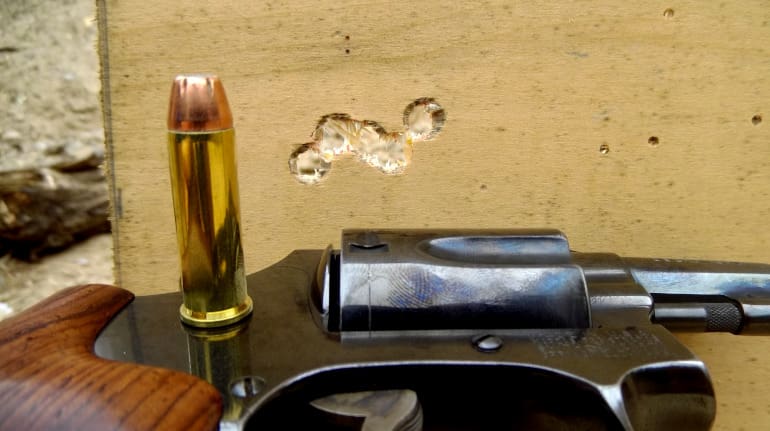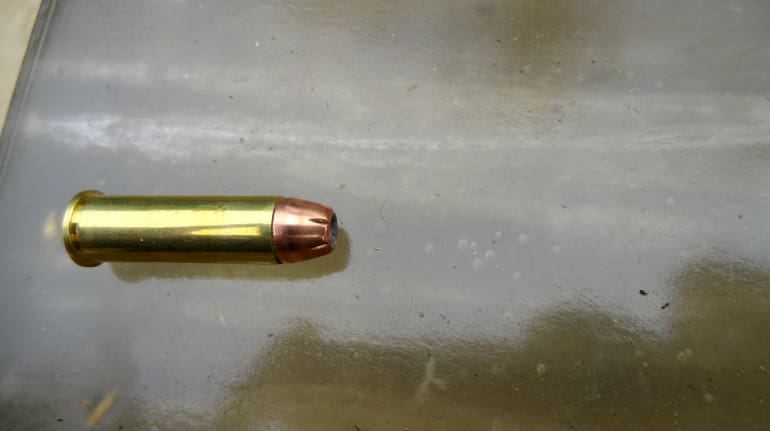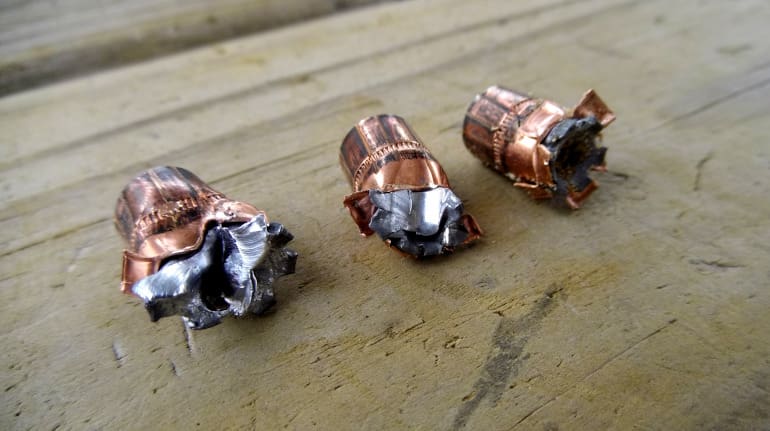
Black Hills Ammunition is an interesting ammo maker. They have had the honor of producing and developing the famous MK 262 Mod 1 5.56x45mm load for the Mk 12 Special Purpose Rifle as well as supplying civilians with top-quality self-defense, sporting, and hunting ammo. I recently reviewed their excellent 9mm 100gr +P HoneyBadger on these pages and it was phenomenal. Today we’ll take a look at their .38 Special 125gr JHP +P for you wheelgunners.
General Background:
The bullet used in this load is a tough, traditional jacketed hollowpoint. It displays a slightly heavier crimp than other .38 +P loads I’ve seen and used, but it is not extreme. I hear all sorts of things about crimp these days when it comes to carry ammo, especially that it results in high pressure spikes. Most of that is bunk. Black Hills know what they’re doing and I found this ammo to be extremely consistent.
The load itself consists of a 125gr bullet and brass case. The ammunition comes in boxes of 50 and carries a street price of about $35-38.00.
Accuracy and Basic Performance
I tested this ammo in my 1970’s era Smith & Wesson Model 36. This gun is a steel-framed 5-shot snub nose with a 1 7/8” barrel. For those who may be concerned, this gun is easily capable of firing what is now +P by today’s standards. This Black Hills load is very similar to what was standard pressure .38 Special when the gun was made.

This is a very accurate pistol for a snubbie and has delivered some excellent .38 groups. The results with the Black Hills load were no different.
It was able to almost one-hole from a rest at ten yards and easily printed one-inch groups from a standing position. The Black Hills load had sharp, but not painful recoil as compared to other loads I’ve tested in the gun. Follow-up shots were easy enough and I was able to point-shoot with no issues inside 15 yards.
In the time I spent testing this cartridge, I experienced no failures to fire or extract. Velocity was chronographed with my Oehler 35P at five feet from the muzzle and averaged 875fps.
Ballistic Performance
I received a 10% FBI gel block from Clear Ballistics for this part of my testing. The Black Hills load was fired from the Model 36 at a personal defense distance of ten yards. The bullets were first fired into bare gel and penetrated completely after expansion.
The 124gr bullets easily handled normal fabric, denim, and leather. Expanded bullets were difficult for me to find when firing through these materials, but I did have a few that I managed to find behind the gel testing setup.

I then moved on to testing the load against more durable and harder materials. The bullets were capable of aggressive penetration through plywood and drywall. The Black Hills rounds came out mangled, but were still fully capable of passing through the entire gel block. They did show signs of expansion, but also displayed evidence of tumbling.
Wounding Capacity
I’m not entirely sure what magic sauce Black Hills puts in this ammo that allows it to be so catastrophic from so short a barrel. I’ve tested a great many .38 loads in gel and against barriers, but this one is something else. I feel as though I’ve just about seen it all when it comes to what the .38 can deliver, but I have to say I was surprised.

The wound channels generated by this load displayed deep and wide permanent cavities, easily better than most 9mm bullets I’ve tried from longer barrels and certainly more than other .38s. The initial wound cavities measured a fairly nominal 3-4” long and .5” wide, but they had significant yawing and tumbling after about 6”.
The impressive penetration of this load was plainly evidenced when shooting through fabric and barriers. The damage done was far greater than when shot through plain gel. The bullets tended to rip and tear tissue all the way through and showed no signs of slowing down, such as reduced-diameter wound channels.
Most impressive was the fact that these loads were capable of staying together and doing damage after passing through two layers of leather and three of t-shirt fabric after having blown straight through a piece of drywall. I found this particular bullet at a depth of 14” in the gel. It is the one on the far right in the photo. You can still see some of the leather jammed in the tip.

Overall Impressions:
This is a very powerful .38 Special +P load that makes use of a tough, reliably-expanding bullet. This is old-school, 1970’s rough-and-tumble mustachioed detective ammo that’s made to work and doesn’t seem to care about what is has to go through to get at (or through) a bad guy.
But what about the overpenetration, Josh? You should be aware of that potential if you choose to carry this round. That said, this is the ammo that I carry in my own gun now, and don’t see it as much more of a risk than a 124gr 9mm or .357 Mag. The gel isn’t exactly the same as a hostile attacker, with no bones. But I do like that I know I can reach said bones reliably, even though the bad guy may be wearing lots of clothing and a coat.
Ratings (out of five stars):
Accuracy: * * * * *
This load could be half as accurate and still be better than some of the other .38 I’ve tried over the years. Well within minute of bad guy.
Handling: * * * *
Recoil was stiffer than I was expecting, but still manageable. Follow-up shots were quick, but I could tell I had more muzzle jump than a couple other personal defense loads I use regularly.
Reliability: * * * * *
No problems at all with this ammo.
Terminal Performance: * * * *
As a carry round, it will get the job done. And then some. One star off because the risk of significant over-penetration, but I have to say that I want all the penetration I can get out of a concealed carry gun’s barrel that’s less than 2” long. As a fighting round, this is peak performance for .38 Special.
Overall: * * * * 1/2
This is a very good .38 load. I trust it and it currently sits in each chamber of my Model 36 as I sit writing this in a filthy hipster coffee shop at 6:30pm on a Wednesday in a socially ambiguous part of town that’s trying its very best to resist gentrification. Again, I trust it. Black Hills has a real winner here and you’d do well to pick up a box and try it yourself.




…but how does it compare to the BH Honey Badger .38 spl load? Which would you use?? DMD
They are very different. I have more than one J Frame and I carry both loads regularly. I’ll be reviewing the Honey Badger .38 in the weeks to come.
Keep up the .38 ammo testing! Lots of Snubbies still out there.
^^this^^^
Please add a photo or two of the gel results. You say the bullet tumbled, and pictures would help us in getting a sense of the results. Thank you for this review; it covered a brand that we would not generally consider, or even know at all.
Addendum: SOME gel pics are shown on the mfr w-site, but:
a) We need independent gel testing before making the very important choice of ammo selection, not just a company’s claims.
b) Black Hills’ pics of gel tests show results from a 4-inch barrel, which hardly anyone uses in .38 special anymore; we need to see results from snub-nosed barrels; 2″ or shorter.
c) In DIFFERENT calibers…NOT the .38 discussed in this article…overpenetration from this kind of ammo is kinda terrifying. The .45 version of this ammo, in 230-grain wt., pentrated 32″ in gel.
I say again: I am referring to a DIFFERENT version of this ammo when I express concern, not the .38 version…which may just become my self-defense ammo of choice in my revolver.
BH does offer a 185-gr version of its .45 ACP; should penetrate less, but still far too much for self-defense use. BH’s website shows no pics of gel testing in lighter, less-penetrating versions in .45.
I stand the same as always, with my “J” frame and any 125-140 .38spl +P. No matter what the 9mm fanboys say, the .38 is always just a little better, given equal pressure loads. People mostly don’t know that standard pressure is considered to be <17K PSI for the .38 but <35K PSI for the 9mmP. Quite an advantage for the 9mm, but, ofc, one can always load .38s at +P levels the same as one can 9mms.
Just be aware that SAAMI will call 18,000 PSI +p in the .38 while 34,000 PSI will just be standard pressure for a 9mmP. OFC, the firearm will know the difference, as will any stress measurements of a fired case. All SAAMI specs are relative, the absolute numbers mean little without context. In this case, the .38 spl is held to extremely low pressure because there still exist old firearms chambered in this caliber from the turn of the LAST century! These century old guns do not have the quality of materials that we enjoy today, and have likely gotten even weaker with time. So SAAMI holds the .38 down so that those people can still shoot today's .38 ammo in their 100+ year old guns.
If one has a more modern .38 caliber firearm, there is little need for loads as anemic as 17K, unless it is for the lower recoil and noise levels.